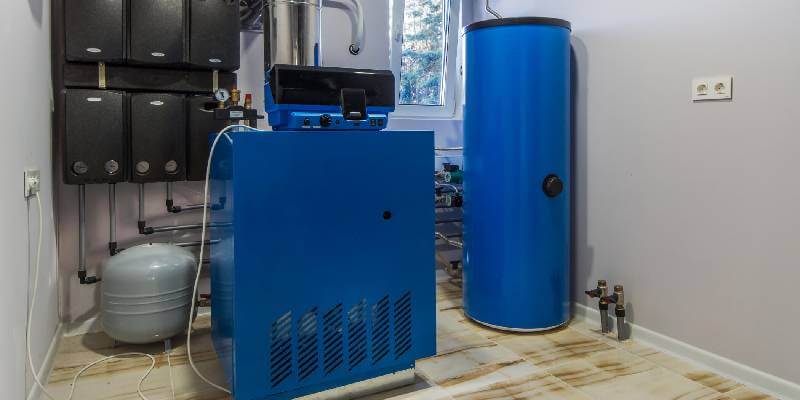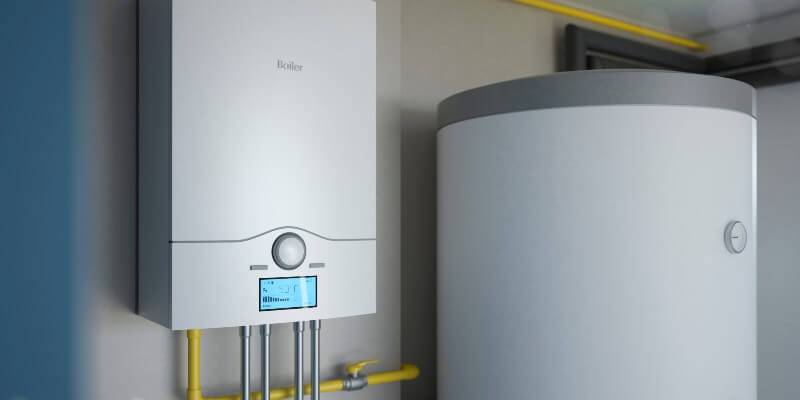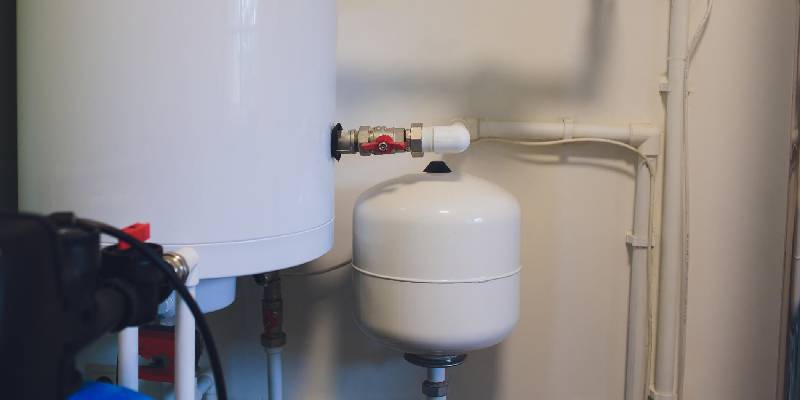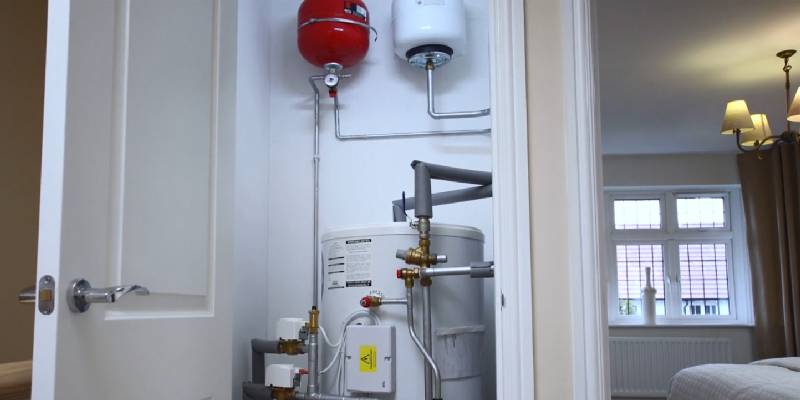Hot water cylinders can be found in many homes, often tucked away in an airing cupboard, out of sight and out of mind. But what is a hot water cylinder? What is the difference between a vented and unvented cylinder? These are questions that every homeowner should know the answer to. Thankfully, this article will explain the key features of both vented and unvented cylinders, as well as explore the pros and cons of buying, installing and maintaining each type.
As for what a hot water cylinder actually is, that’s quite simple! It is a large, cylindrical tank used to store water heated either by the boiler, or inside the cylinder by an immersion heater for later use in the home. This means that instead of having to wait for the boiler to heat water as and when you need it, you have an instant supply of hot water at your fingertips! Pretty nifty, right?
What’s The Difference Between A Vented And Unvented Cylinder?
It is important to know the difference between vented and unvented cylinders for several reasons. For example, if a problem were to develop with your hot water cylinder, knowing whether it is vented or unvented is key to solving the issue. Likewise, knowing the difference is extremely valuable when looking at purchasing a new property or replacing the cylinder in your current one, as this enables you to make an informed choice based on the needs and means of you and your family.
This is why we have put together this article explaining vented and unvented cylinders, the difference between them, and the benefits and disadvantages of each. With over three decades of experience in the plumbing and heating industry, our team have completed a fair few projects involving hot water cylinders over the years, including boiler installations in Milton Keynes. We have all the necessary knowledge, expertise and qualifications to break down the important points about the different types of hot water cylinders. Here is everything you need to know:
- Vented Cylinders
- Unvented Cylinders
- Vented vs Unvented Cylinders
- FAQs
Find out more:
Sign Up For Our Newsletter
Stay in the loop with tips, advice and updates!
Vented Cylinders
Vented cylinders are the traditional version of the hot water cylinder and are typically made from copper or, as of more recently, stainless steel. Vented cylinders are fed water from a cold water tank, typically found in the attic. This is because vented hot water cylinders rely on gravitational force to create a steady flow of water to outlets around the household, meaning that the cold water tank must be located above it. Because this gravitational force and water supply are consistent, the pressure of the water released from each outlet around the home is also consistent. However, the potential locations of the cylinder are limited due to its reliance on the cold water tank, and the pressure of the water produced by outlets may vary throughout the house, depending on the vertical distance from the cold water tank.
An advantage of opting for a vented hot water cylinder in your home is that they are highly cost-effective. They are relatively straightforward and therefore inexpensive to install and rarely need maintenance work. The majority of hot water cylinders in the UK are vented ones, meaning that when it comes time to replace your cylinder, opting to stick with a vented system will save you lots of money in comparison to the cost of reconfiguring your home to accommodate the installation of an unvented cylinder.
To summarise:
| Pros | Cons |
|---|---|
| Inexpensive installation and maintenance | Limited possible installation locations |
| Constant water pressure from individual outlets | Water pressure may vary between outlets |
| Save money with a ‘like for like’ replacement | Require attic space for a cold water tank |

Unvented Cylinders
Unvented hot water cylinders are a more recent invention than the vented hot water cylinder. Rather than relying on a cold water tank stored in the attic for water supply, unvented cylinders use the cold water mains as a direct supply. This means that the location of the cylinder is not restricted by the position of a cold water tank.
As the water in the mains is already pressurised, hot water delivered to outlets via an unvented cylinder will be at mains pressure, meaning that unvented cylinders generally offer a better flow rate than vented ones. However, mains water pressure can decrease at times of high demand, so it is slightly less reliable than that provided by an attic cold water tank. Unvented cylinders are closed off, unlike their vented counterparts, meaning that they require an expansion vessel. This is because water expands in volume as it heats up, so the system must include an overflow area to prevent the pressure inside the cylinder from rising to dangerous levels.
Due to the more complex nature of the unvented cylinder, it is absolutely essential that it is installed by a qualified professional and receives annual maintenance in order to ensure that it meets all safety regulations. Our team of heating technicians and plumbers in Milton Keynes are more than happy to help if you require a cylinder installation, repair or maintenance service. Please feel free to get in touch with us to find out more.
To summarise:
| Pros | Cons |
|---|---|
| Hot water delivered at mains pressure | Costly installation |
| No cold water tank required | Yearly maintenance is essential |
| Can be located almost anywhere in the home | Less reliable pressure |

Vented vs Unvented Cylinders
Now that we’ve covered both vented and unvented cylinders, it’s time to compare the two! In order to decide which type of cylinder is best suited to your home and the needs and means of you and your family, you need to consider the importance of the following things:
- Cost
- Attic space
- Water pressure and flow rates
- Flexibility over where your cylinder is located
If cost is your primary concern, a vented cylinder is the best option for you due to its low installation and maintenance costs, especially if you are replacing an existing vented cylinder. Along with saving money by choosing this option, you will benefit from highly reliable water pressure. However, downstairs outlets may produce water at a higher pressure than upstairs ones due to the gravitational mechanism of the system. If you would prioritise high water pressure and flow rates, flexibility over the location of your cylinder and preserving attic space (e.g. if you would like an attic bedroom) over cost, we would recommend choosing an unvented cylinder. These free up space by eliminating the need for a cold water tank in the attic, which also means that your cylinder can be installed practically anywhere in your home, including in the attic space. They also offer higher water pressure and flow rates than vented cylinders do.
To summarise:
| Vented | Unvented | |
|---|---|---|
| Cost | Inexpensive installation and maintenance | Expensive installation and maintenance |
| Attic Space | Used up by cold water tank, can’t use to store cylinder | Unaffected, can be used to store cylinder |
| Water pressure | Consistent pressure from individual outlets but differs between outlets | All outlets run at mains pressure but this can fluctuate |
| Cylinder location flexibility | Minimal, must be located beneath cold water tank in attic | Great, can locate almost anywhere in the home |

FAQs
Here are the answers to some common questions about vented and unvented hot water cylinders:
Can I Use An Unvented Cylinder In A Vented System?
Yes! You may want to use an unvented cylinder in a vented system if it has come time to replace your vented hot water cylinder, and you would like to convert your home to an unvented system one day but do not currently have the means. This way, you can avoid having to replace your new cylinder prematurely when you are ready to convert, as well as spread out the cost of the conversion.
What Is The Difference Between Direct And Indirect Cylinders?
Direct hot water cylinders heat water directly, for example, using an immersion heater. Meanwhile, indirect hot water cylinders heat water using an external source such as a boiler. Both vented and unvented cylinders can be direct or indirect.
Why Is There No Hot Water In My Cylinder?
If the thermostat on your cylinder indicates that the water it contains is not hot enough, there may be a problem with your boiler. If you are in need of boiler repairs in Milton Keynes, please do not hesitate to contact our team!

Vented And Unvented Cylinders Explained
We hope that this article has helped to inform you about vented and unvented hot water cylinders and the difference between them, as well as give you some points to consider when choosing a cylinder for your home. Whether you have made your mind up already and are ready to look into installation, or have more questions and would like some professional advice, why not get in touch with us at Bishop Plumbing And Heating today? Our talented team are highly experienced, having completed numerous projects, including cylinder installations, general plumbing and gas safety checks in Milton Keynes and the surrounding areas.












